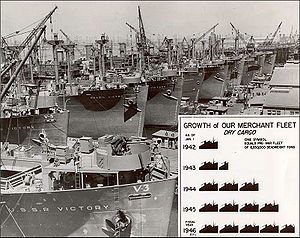
War Shipping Administration
Encyclopedia

World War II
World War II, or the Second World War , was a global conflict lasting from 1939 to 1945, involving most of the world's nations—including all of the great powers—eventually forming two opposing military alliances: the Allies and the Axis...
emergency war agency of the US Government, tasked to purchase and operate the civilian shipping tonnage the US needed for fighting the war.
On February 7, 1942, WSA was established by President
President of the United States
The President of the United States of America is the head of state and head of government of the United States. The president leads the executive branch of the federal government and is the commander-in-chief of the United States Armed Forces....
Franklin Delano Roosevelt's Executive Order No. 9054. February 7, 1942 as the U.S. had entered the war. The WSA was administratively split off from the United States Maritime Commission
United States Maritime Commission
The United States Maritime Commission was an independent executive agency of the U.S. federal government that was created by the Merchant Marine Act of 1936, passed by Congress on June 29, 1936, and replaced the U.S. Shipping Board which had existed since World War I...
, established in 1936, which oversaw design and construction of merchant type vessels. Those included the production of Liberty ship
Liberty ship
Liberty ships were cargo ships built in the United States during World War II. Though British in conception, they were adapted by the U.S. as they were cheap and quick to build, and came to symbolize U.S. wartime industrial output. Based on vessels ordered by Britain to replace ships torpedoed by...
s and Victory ship
Victory ship
The Victory ship was a type of cargo ship produced in large numbers by North American shipyards during World War II to replace shipping losses caused by German submarines...
s among other types. The U.S. fleet expanded to some 3,500 dry cargo vessels and over 900 high speed tankers. On a practical level the The Maritime Commission and the WSA worked closely together under the administration of Vice Admiral Emory S. Land
Emory S. Land
Vice Admiral Emory Scott Land was an officer in the United States Navy, noted for his contributions to naval architecture, particularly in submarine design. Notable assignments included serving as Chief of the Navy's Bureau of Construction and Repair during the 1930s, and as Chairman of the U.S...
at the head of eachhttp://www.ibiblio.org/hyperwar/ATO/Admin/WSA/MMatWar-44/index.html | War Shipping Administration Report to The President, 1944. Land described this relationship in his report to The President of WSA's progress through December 31, 1943:
- "Under the Merchant Marine Act of 1936, the United States Maritime Commission was established as an independent agency to direct and control all phases of overseas shipping and shipbuilding. It became apparent immediately when this Nation entered the war that a special agency to deal with the operational problems peculiar to war was necessary to supplement the Maritime Commission. That need brought about the creation of the War Shipping Administration on February 7, 1942, which took over from the Maritime Commission virtually all of the Commission's major statutory functions with the exception of shipbuilding. Thus WSA became the Government's ship operating agency and the Maritime Commission its shipbuilding agency."
The WSA authority was extensive. In the same report to the President, Land describes the responsibility:
- "The responsibility of the WSA under the Executive Order of February 7, 1942, extended to all phases of shipping including the purchase or requisition of vessels for its own use or the use of the Army, Navy, or other Government agencies; the repairing, arming, and degaussing of WSA controlled vessels and Allied vessels under lend-lease provision; conversion of vessels to troop transports, hospital ships, and for other special purposes; training and providing ship personnel, operating, loading, discharging and general control of the movement of these ships; administering and marine and war risk insurance laws and funds, and the control of terminal and port facilities, forwarding and related matters."
Under that authority cargo hulls were allocated to either commerce, Army or Navy. Many of the Army's ships and Naval transports were allocated by WSA. In addition, the WSA worked closely with the British Ministry of War Transport through the Combined Shipping Adjustment Board in ensuring most efficient use of available ship hulls and cargo carrying capacity. Under the "loading, discharging and general control of the movement of these ships" WSA developed and enforced improved methods of utilizing ship capacity and avoiding inefficient use of ships by commerce and the military services
After the war, WSA vessels were used to carry home the huge number of armed personnel overseas, as part of Operation Magic Carpet. Over 3,500,000 men were brought home from overseas areas by December 1, 1945.
On September 1, 1946, the WSA functions were returned to the Maritime Commission.
External links
- United States Government Manual, 1945 War Shipping Administration section
- http://www.usmm.org/
- http://www.ibiblio.org/hyperwar/ATO/USGM/MC.html
- http://www.us-maritime-commission.de

